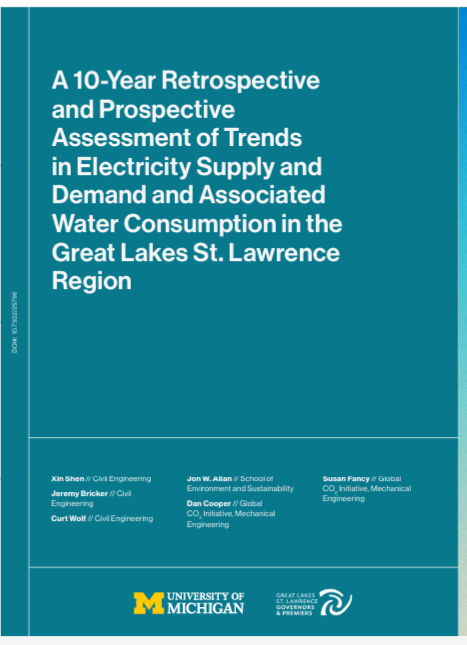Conference of Great Lakes St. Lawrence Governors and Premiers to use report findings to help guide region's economic competitiveness and appeal for future industries
CHICAGO, IL / ACCESS Newswire / October 1, 2025 / Today, in advance of its Leadership Summit in Québec City, the Conference of Great Lakes St. Lawrence Governors and Premiers (GSGP) released the findings of a first-ever report that looks at energy generation and transmission across the Great Lakes St. Lawrence region.
The cover page of the report highlighting 10-years of electricity use in the Great Lakes region
Click here to read the full report.
Titled "A 10-Year Retrospective and Prospective Assessment of Trends in Electricity Supply and Demand and Associated Water Consumption in the Great Lakes St. Lawrence Region," the report, conducted by the Global CO2 initiative at the University of Michigan, used public data from 2014 to 2023 to provide a retrospective and prospective assessment of the region's electricity generation and related water use.
Ms. Susan Fancy, Managing Director of the Global CO2 Initiative, will be presenting the report's findings at this weekend's Leadership Summit of the Great Lakes St. Lawrence Governors and Premiers in Québec City.
GSGP aims to assess strategies to boost the region's economic competitiveness and attractiveness as a hub for energy-using industries.
"This report is enlightening as it provides historical context while also projecting future electricity supply and demand as we look to support a growing economy, in the future," said David Naftzger, GSGP's Executive Director.
Overall, the study found that the region's shift from coal and nuclear to gas, solar, and wind energy production has led to significant decarbonization and reduced water use, while supporting an increase in regional economic output, as measured by GDP. More efficient energy production and decreased water use from the power sector offers new potential economic opportunities for the region.
Key questions that were addressed in the report included:
How much electricity is generated in the region?
How is the region meeting its renewable energy demand?
Where are the primary transmission lines in the region?
What is the net import or export of electricity into or from the region by source?
Which States or Provinces are the largest exporters?
What are the projected changes in electricity, fuel, and water use consumption?
What are recommendations for achieving optimal outcomes?
Key insights from the study include:
The region produces more energy than it consumes, and it has an opportunity to consider the best economic use of excess regional energy.
Energy consumption in the region over the last 10 years has been largely stable, while real GDP at the Provincial and State levels has grown.
The region has conserved billions of gallons of water annually related to electricity production.
The region's electric system operates as a whole with considerable interstate/interprovincial and international power flows.
Contact Information
Craig Clark
PR Contact
craig@clarkcommunication.com
616-550-2736
SOURCE: Great Lakes Governors and Premiers
View the original press release on ACCESS Newswire





